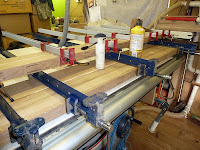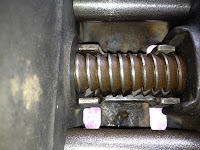I've had one of these now tucked away in the corner of the workshop for years and never used it; I bought two more, a couple of 30" old dogs, all rusty off of e bay, a few weeks back; I paid £17.00 including the postage for the pair, bargain, you know the usual, missing pins old bolts thread all rusty difficult to use etc.
I don't like fiddling with bolts while I'm trying to clamp and assemble something together, with the glue setting off fast. I decided to refurbish them to their original condition. After a little research for Records replacement pins with chains, which cost out at £10.95 per clamp * 3 £32.85 Nah. I decided to source my own Material.
My first find was the tapered pins I used 2" * 11/32" *10 from e bay. I purchased a pack of 10; thirteen were in the packet (extra nice) at £5. A quick trip to B/Q 2m of chain £4.40. Euro fasteners for the split ring for each end of the chain 20 £1.60 enough materials to do ten in number clamps total cost £11.
First, a bloody good de-rust all around and a quick coat of blue paint made them much more presentable, as seen above.
When the pins turned up, they were slightly bigger in diameter than I had anticipated,
but no problem. I re-drilled all the holes along the length of the
clamps using the variable speeds drill I recently refurbished (startrite)
using an 8.5mm drill on a speed of 210 rpm the drill went through these clamps like
slicing through butter. To hold the pin while I drilled through it. I
drilled a 6mm hole at the end of an offcut of oak, taped in the tapered pins till they just nipped in tight, and then clamped the oak in the
drill vice as shown below.
 The rest was straight forward cutting lengths of chain feeding split rings on at both ends and then connecting them to the heals of the bottom shoe's through there pre-drill holes and the other end through the new holes that I drilled in the tapered pins. Here in this photo shows all three new pins connected and finished with all the old and new bling left over.
The rest was straight forward cutting lengths of chain feeding split rings on at both ends and then connecting them to the heals of the bottom shoe's through there pre-drill holes and the other end through the new holes that I drilled in the tapered pins. Here in this photo shows all three new pins connected and finished with all the old and new bling left over.
There you go three old dogs refurbished, ready to use, that now leaves me to oil them all over and make a rack to hang them on with enough space for a load more clamps still to come.
Finally, the hanging rack, simply made from offcuts of scrap, has four slots cut to allow for an extra 30" clamp to make up a complete second pair. Enough space to the right to hang my 48" clamps and space in the middle to hang a set of 36 " clamps, but that's another thread.


Finally, the hanging rack, simply made from offcuts of scrap, has four slots cut to allow for an extra 30" clamp to make up a complete second pair. Enough space to the right to hang my 48" clamps and space in the middle to hang a set of 36 " clamps, but that's another thread.


ps.
The split ring used was smaller than what was originally used by the record. I found that they got in the way when clamping and could get caught up and crushed, ending up all bent and twisted and sometimes broken. That's why some pins were missing, so I bought smaller rings; they are fiddly to fit but well worth the trouble.















































